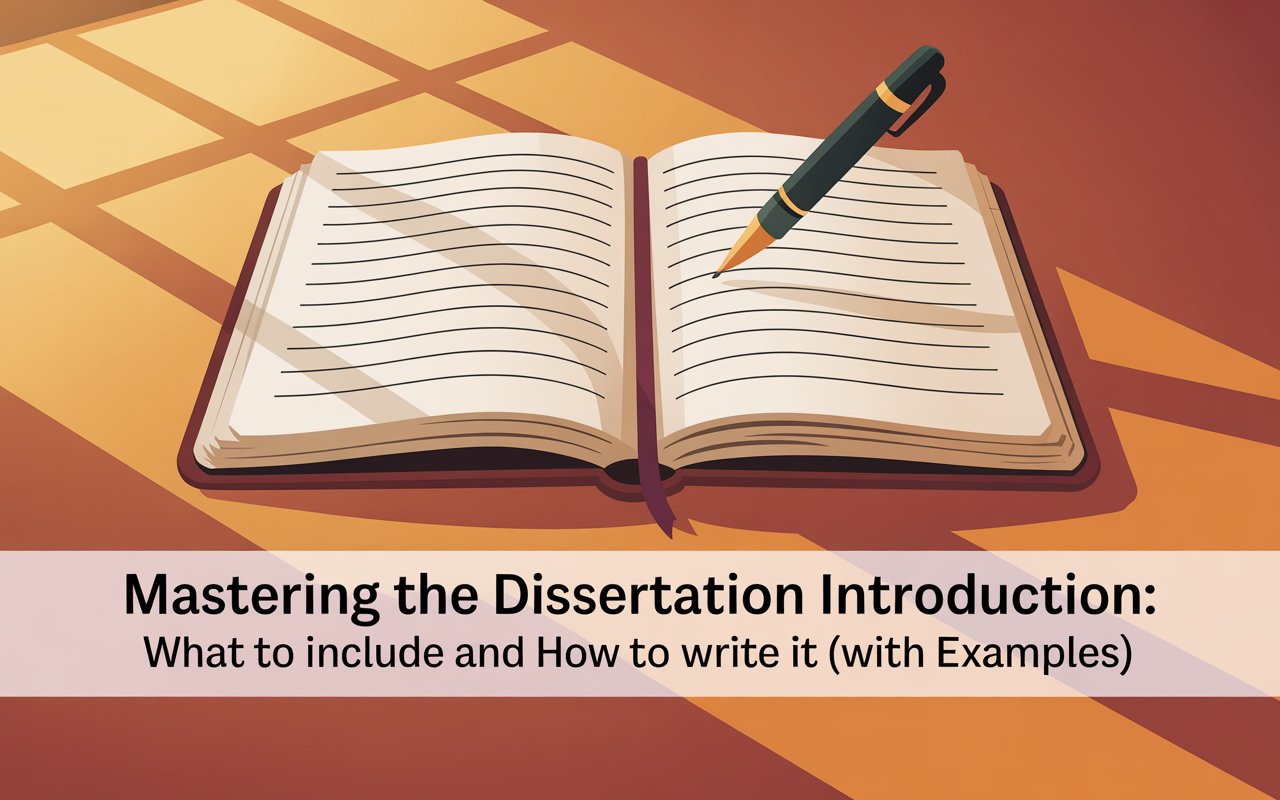Mastering the Dissertation Introduction: What to Include and How to Write It (With Examples)

Strong 8k brings an ultra-HD IPTV experience to your living room and your pocket.
Introduction
Your dissertation carries a lot of weight; it’s not just another assignment, but a major part of your final grade. For many students, their entire university journey depends on how well they perform in this one project. Choosing a topic might come easily, but writing the introduction is where things often get complicated. It’s not just the first chapter; it’s your reader’s first impression, and getting it right takes time, clarity, and structure. The introduction is a vital part of your dissertation, setting the tone for your entire project. It provides the background, highlights the research gap, and justifies the study's significance. This section guides the reader into your research, making it essential to be clear, focused, and well-structured. A strong introduction helps establish the purpose of your study and aligns your work with academic expectations, making it a crucial first step in your dissertation journey.
What Is a Dissertation Introduction? (100–120 words)
The dissertation introduction is the first formal chapter of your thesis or dissertation, and it sets the tone for the entire document. It helps the reader understand what your research is about, why it matters, and how you plan to approach it. Unlike the abstract, which provides a summary of your whole study, the introduction offers context, focus, and direction right from the start.
Here’s what a strong dissertation introduction typically includes:
- Background to the topic – A brief overview of the subject area and existing research.
- Problem statement – Clearly defines the issue or gap your research addresses.
- Research aims and objectives – What your study intends to achieve.
- Research questions or hypotheses – The specific questions guiding your investigation.
- Scope of the study – What will and won’t be covered.
- Significance of the study – Why your research is important academically or practically.
-
Dissertation outline – A summary of what each upcoming chapter will cover.
If you're still unsure how to structure this first chapter or feel overwhelmed by where to begin, Scora's dissertation helpers can help you craft a strong, tailored introduction aligned with your research goals.
Expert Tip: Generally, the introduction should make up about 10% of your total word count, roughly 1,000 to 1,200 words for a 10,000-word dissertation.
What to Include in a Dissertation Introduction?
Writing a dissertation introduction is all about creating a foundation for your research. We will understand each of the components with real-time dissertation introduction examples:
1. Background to the Topic: Set the Stage with Context That Matters
The background section of your introduction plays a vital role in establishing the context for your research. It introduces your research area to the reader, provides relevant background information, and highlights the importance of your study within the broader field.
How to write it well:
Suppose your research is on “Automated Translation from Standard English to Simplified Technical English Using Large Language Models"
- Start broadly by introducing the general research area.
- Discuss current trends, challenges, or debates within the field.
- Review significant prior studies and their findings.
- Highlight limitations or gaps in existing knowledge.
- Narrow down gradually to your specific research problem.
- Clearly connect how your study aims to address these gaps.
- Maintain a logical flow from broad concepts to specific issues.
- Keep the background focused and relevant to your research question.
Example:
- Recent advancements in natural language processing have seen large language models like GPT-3 and T5 revolutionize language translation and text simplification tasks (Hagos, Battle and Rawat, 2024).
- The increasing complexity of technical documents necessitates automated systems to make content more accessible.
- Traditional methods of technical translation rely on manual editing or rule-based systems, which are often time-consuming and costly (Whiteglobe, 2024).
- Recent research demonstrates that LLMs can effectively translate complex technical content into simplified English while maintaining accuracy (danielallred, 2024).
- Studies have evaluated translation quality using BLEU scores, readability indices, and correctness checks, showing promising results.
- Despite progress, there is a lack of comprehensive comparative analysis of different LLMs across various technical domains (Jahan et al., 2024).
- This gap restricts the development of reliable, scalable, automated technical translation tools.
- Tip to score higher: Show you’ve read widely but write concisely. Use up-to-date global data and peer-reviewed sources.
2. Aim: Define What Your Research Intends to Do
Why it matters: Your aim is the anchor for your dissertation. A weak or vague aim can confuse your reader and your own direction.
How to write it well:
Write a brief statement that outlines the primary goal of your research.
- The aim of your research should clearly articulate the purpose of your project in a single statement, ideally beginning with an infinitive verb (e.g., “to determine,” “to investigate,” “to develop”).
- Follow the verb with an action that captures the essence of your inquiry.
- This ensures that the aim addresses what you intend to investigate, how you plan to approach it, and remains concise while guiding your research direction.
For example:
- The research aims at developing an automated system that translates complex technical documents from Standard English into Simplified Technical English to enhance accessibility for a non-expert audience.
Tip to score higher: Ensure your aim connects directly to the problem statement and leads into your objectives.
3. Objectives: Break the Aim into Actionable Steps (Use SMART)
Why it matters: Clear objectives show you’ve thought practically about execution. Vague or overlapping objectives are common reasons for grade drops.
How to write it well:
- When crafting objectives for your experiment or research project, it’s important to articulate specific goals that detail what you intend to achieve.
- Each objective should begin with the word “to,” followed by an action verb that clearly defines the task at hand.
- Examples of effective action verbs include “to review,” “to analyse,” “to design,” “to compare,” “to measure,” and “to evaluate.”
- This structure helps in outlining the steps needed to fulfil your aim and provides clarity on the direction of your study.
For example:
- To train a model that simplifies technical content while keeping its original meaning intact.
- To assess the model’s effectiveness using readability measures and translation quality metrics.
- To create an automated translation process that will aid accessibility in technical writing.
- Tip to score higher: Put time frames next to each goal. This shows feasibility, something markers look for in high-band dissertations.
4. Research Questions: Frame the Inquiry That Drives Your Work
Why it matters: Your research questions tell the reader what you’ll answer, not just what you’ll “study.”
How to write it well:
- To develop meaningful research questions, begin by pinpointing the specific problem or issue your study aims to explore.
- Each question should start with question words like "what," "how," "why," or "to what extent" to guide the inquiry.
- Make sure your questions are precise and targeted; they should strike a balance, neither too broad nor too narrow, and should encourage detailed investigation rather than simple yes/no answers.
- It’s important that the questions reflect the main objectives of your research, providing enough scope for thorough analysis while staying within the boundaries of your study's focus.
- For instance:
RQ1: How can large language models be trained to effectively simplify technical documents into simplified technical English?
RQ2: What are the methods that could provide simplified language without loss of essential technical details?
Tip to score higher: Keep it focused, 2–3 solid questions are better than 5 irrelevant ones.
5. Significance of the Research: Prove the Impact
Why it matters: This is where many students either brag or underplay their work. Your job is to position your research, who benefits, and how?
How to write it well:
- Clearly identify the main problem or knowledge gap that your research aims to address, emphasizing its significance and relevance within the field.
- Illustrate how your study proposes effective solutions or advancements to the issues identified, highlighting its practical impact.
- Outline the potential contributions and broader implications of your research, underscoring its importance, timeliness, and relevance in current academic or industry contexts.
- Describe the new insights your research offers, whether it challenges existing theories, enhances research methods, or explores understudied areas, thereby advancing understanding in the field.
- Specify the primary beneficiaries of your findings, such as researchers, industry professionals, policymakers, or society at large, and explain how they will benefit from your work.
- Support your claims by referencing relevant literature and clearly identifying the gaps your research aims to fill, demonstrating its necessity and value.
- Highlight any innovative features of your study, including unique perspectives or novel approaches that set your work apart.
- Through concise and focused presentation, demonstrate the theoretical, practical, methodological, and societal significance of your research, effectively justifying its importance and relevance.
Example:
In order to address challenges related to understanding complex technical documents, this study is centered on the development of an automated translation system providing translation from Standard English to Simplified Technical English. Traditionally, such translations rely upon human translators, which could make it a time-consuming and costly process, thus limiting accessibility on the part of non-experts (Moneus and Sahari, 2025). This project aims to automate the simplification process while preserving the original intent, using LLMs such as GPT-3 and T5 (Meltem Kurt Pehlivanoğlu et al., 2024). The innovative use of these advanced models permits better handling of technical jargons and formation of complex sentences, thereby bringing about better audience understanding. In addition, this study will use several measures for evaluating performance, including BLEU scores and readability, and checking simplification correctness to assess the quality and readability of generated content (Otten and Otten, 2024). It aims to bring technical documents closer to the public and, simultaneously, makes the field ready for an automated simplification tool for other forms of writing.
Tip to score higher: Name who benefits, clinicians, rural patients, policymakers, and how. This strengthens real-world alignment.
6. Structure of the Dissertation: Give the Reader a Map
Why it matters: Your reader should never feel lost. A brief outline of the chapters shows planning and improves flow.
How to write it well:
This section describes the structure of the dissertation, giving an overview of how it is organized.
- Begin with the introduction, which sets the context and introduces the main research question.
- Follow with the literature review, explaining how it offers background information and highlights existing gaps in knowledge.
- Then, outline the methodology chapter, focusing on its explanation of the research design and data collection techniques.
- Next, briefly describe the data analysis and results chapters, showing how they present the study’s key findings.
- Conclude with the discussion or conclusion chapter, which interprets the results and connects them back to the initial research question.
Example:
- Chapter 1 introduces the research problem, outlining the importance of effective network intrusion detection and stating the aims and objectives of comparing Snort, Suricata, and Zeek.
- Chapter 2 provides a comprehensive review of existing network intrusion detection systems, discussing their capabilities, limitations, and the criteria for evaluating their performance.
- Chapter 3 describes the research methodology, including the setup of network environments, the criteria for selecting test data, and the procedures for measuring detection accuracy, resource usage, and response times.
- Chapter 4 presents the experimental results, including quantitative data on detection accuracy, false positive/negative rates, resource consumption, and response times for each IDS.
- Chapter 5 analyzes and interprets the findings, comparing the strengths and weaknesses of Snort, Suricata, and Zeek across different network scenarios, and discusses implications for practitioners.
- Chapter 6 concludes the dissertation by summarizing key insights, acknowledging limitations, and suggesting directions for future research in network intrusion detection systems.
Tip to score higher: Use transition phrases, “this chapter builds on…” to show how each section contributes to your research journey.
Conclusion
Writing a strong dissertation introduction is your chance to impress from the very first page. It should present your topic, identify a meaningful research gap, define aims and objectives, and set the stage for the entire study. Keep it focused, use credible sources, and follow a logical structure. A well-written introduction not only boosts your academic score but also builds reader confidence.
References (To Be Added after Chapter 6)
danielallred (2024). Leveraging LLMs to Automate Formality Adaptation in Translation. [online] Welocalize. Available at: https://www.welocalize.com/insights/leveraging-llms-to-automate-formality-adaptation-in-translation/ [Accessed 12 Jun. 2025].
Hagos, D.H., Battle, R. and Rawat, D.B. (2024). Recent Advances in Generative AI and Large Language Models: Current Status, Challenges, and Perspectives. [online] Arxiv.org. Available at: https://arxiv.org/html/2407.14962v5.
Jahan, I., Rahman, T., Peng, C. and Jimmy Xiangji Huang (2024). A comprehensive evaluation of large Language models on benchmark biomedical text processing tasks. Computers in Biology and Medicine, pp.108189–108189. doi:https://doi.org/10.1016/j.compbiomed.2024.108189.
Meltem Kurt Pehlivanoğlu, Robera Tadesse Gobosho, Muhammad Abdan Syakura, Vimal Shanmuganathan and de ‐la‐Fuente‐Valentín, L. (2024). Comparative analysis of paraphrasing performance of ChatGPT, GPT‐3, and T5 language models using a new ChatGPT generated dataset: ParaGPT. Expert Systems. doi:https://doi.org/10.1111/exsy.13699.
Moneus, A.M. and Sahari, Y. (2025). Artificial intelligence and human translation: A contrastive study based on legal texts. Heliyon, [online] 10(6), p.e28106. doi:https://doi.org/10.1016/j.heliyon.2024.e28106.
Otten, N.V. and Otten, N.V. (2024). BLEU Score In NLP: What Is It & How To Implement In Python. [online] Spot Intelligence. Available at: https://spotintelligence.com/2024/08/13/bleu-score-in-nlp/ [Accessed 12 Jun. 2025].
Whiteglobe (2024). White Globe Group Pvt. Ltd. [online] Whiteglobe.co.in. Available at: https://www.whiteglobe.co.in/article/article-by-aachits/manual-translation-to-ai-driven-solutions [Accessed 12 Jun. 2025].
Note: IndiBlogHub features both user-submitted and editorial content. We do not verify third-party contributions. Read our Disclaimer and Privacy Policyfor details.







